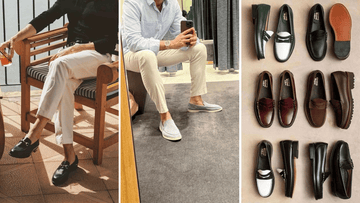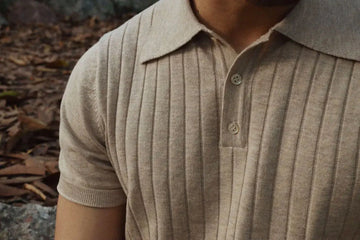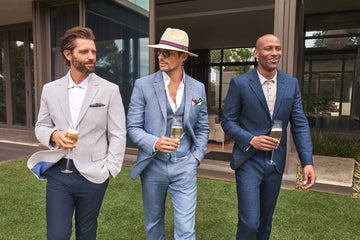Loafers have long been a cornerstone in men's footwear, celebrated for their blend of comfort, style, and versatility. These slip-on shoes, devoid of laces, have evolved over the decades, offering a range of styles suitable for various occasions. In this guide, we'll delve into the world of loafers, exploring their origins, construction, materials, and the diverse types that have made them a staple in men's fashion.
What Are Loafers?

Loafers are slip-on shoes characterized by their laceless design, low heels, and exposed ankles. Originating as casual footwear, they have seamlessly transitioned into formal settings, thanks to their adaptable design. The absence of laces offers a sleek appearance, while their construction ensures both comfort and durability.
Unlike dress shoes that require tying, loafers provide a hassle-free experience while maintaining a refined look. They strike the perfect balance between comfort and formality, making them an essential part of any well-dressed man's wardrobe.
How Are Loafers Made?
The craftsmanship behind loafers is a testament to meticulous design and quality materials. Typically, the process begins with selecting premium materials such as leather, suede, or velvet. The upper part of the shoe is crafted to fit snugly over the foot, often featuring distinctive elements like straps, tassels, or metal bits. The sole is then attached, with options ranging from leather to rubber, depending on the intended use and style. Handmade loafers often boast superior stitching and attention to detail, enhancing both aesthetics and longevity.

-
Material Selection – Premium materials like full-grain leather, suede, or exotic skins (such as alligator or crocodile) are chosen for durability and aesthetics.
-
Shaping the Upper – The upper is crafted through a molding process, ensuring the perfect shape.
-
Stitching and Assembly – Depending on the construction method, the shoe undergoes either Blake stitching or Goodyear welt construction for durability.
-
Sole Attachment – Soles can be glued, stitched, or welted onto the upper, providing different levels of flexibility and longevity.
-
Finishing Touches – Additional embellishments such as tassels, metal bits, or intricate stitching complete the design.
A Brief History of Loafers

The journey of loafers for men began in the early 20th century. Inspired by Norwegian fishermen's slip-on shoes, they gained popularity in Europe and America. The 1930s saw the introduction of the penny loafer, featuring a distinctive strap across the top, which became a symbol of preppy fashion. Over the years, designers have introduced various styles, incorporating elements like tassels and metal bits, cementing loafers' place in both casual and formal wardrobes.
-
1920s-1930s – Norwegian shoemakers crafted the first versions of loafers inspired by slip-on footwear used by fishermen.
-
1936 – The American brand G.H. Bass introduced the Weejun loafer, setting the foundation for penny loafers.
-
1950s – Loafers became associated with Ivy League fashion, making them a symbol of preppy style.
-
1960s – Gucci introduced the bit loafer, adding a touch of luxury with the signature metal horse-bit detail.
-
1980s-Present – Loafers diversified, with designers creating modern interpretations while retaining their timeless appeal.
Types of Materials Used in Loafers
The choice of material significantly influences the look, feel, and suitability of loafers for different occasions:

-
Leather: Classic and durable, leather loafers are ideal for formal settings. They offer a polished appearance and age gracefully with proper care.
-
Suede: Soft and textured, suede provides a more relaxed and casual vibe. However, it requires careful maintenance to prevent staining and damage.
-
Velvet: Luxurious and plush, velvet loafers are often reserved for special occasions or evening wear, adding a touch of elegance to any outfit.
-
Patent Leather: Featuring a glossy finish, patent leather loafers are perfect for black-tie events, offering a sleek and sophisticated look.
Different Types of Men's Loafers

Exploring the various loafer types can help in selecting the perfect pair to complement your style:
-
Penny Loafers: Featuring a leather strap across the top with a small cutout, penny loafers are versatile and can be dressed up or down. They pair well with both suits and casual attire.
-
Tassel Loafers: Adorned with decorative tassels on the vamp, these loafers add a touch of sophistication and are suitable for semi-formal occasions.
-
Bit Loafers: Also known as Gucci loafers, they feature a metal bit across the front, offering a luxurious and stylish appearance. Ideal for formal settings.
-
Belgian Loafers: Known for their lightweight construction and small bow detail, Belgian loafers provide a unique and elegant option for both casual and formal wear.
-
Driving Loafers: Designed for comfort, these loafers have a flexible sole with rubber pebbles, making them perfect for casual outings and driving.
-
Espadrille Loafers: A summer favorite, often made from canvas or soft leather, espadrille loafers are breathable and ideal for warm weather.
-
Slipper Loafers: Crafted from materials like velvet or suede, slipper loafers are suitable for indoor and formal occasions, offering a plush and comfortable feel.
Choosing the Right Loafer Type for Your Style
Selecting the appropriate loafer involves considering the occasion, outfit, and personal comfort:
-
Formal Settings: Opt for leather or patent leather loafers like bit or penny loafers. Pair them with tailored suits or dress pants for a polished look.
-
Casual Outings: Suede or driving loafers complement casual attire such as chinos, jeans, or shorts. They offer comfort without compromising style.
-
Special Occasions: Velvet or slipper loafers add a touch of luxury to evening wear or black-tie events. Ensure they match the formality of your outfit.
How to Care for Loafers
Proper maintenance extends the life of loafers while keeping them looking sharp:
-
Regular Cleaning: Use a damp cloth or suede brush to remove dust and dirt.
-
Conditioning: Leather loafers benefit from occasional conditioning to prevent cracking.
-
Storage: Store loafers with shoe trees to maintain their shape.
-
Weather Protection: Apply a waterproof spray for suede and leather loafers to protect them from moisture.
Styling Loafers for Different Occasions
-
Business Attire – Pair penny or bit loafers with tailored trousers and a blazer.
-
Smart Casual – Wear suede loafers with chinos and a polo shirt.
-
Casual Weekend Look – Driving loafers with jeans and a linen shirt offer a relaxed vibe.
-
Evening Wear – Opt for velvet or patent loafers with a tuxedo for formal events.
Conclusion
Understanding the different types of men's loafers allows you to make informed choices that enhance your wardrobe. Whether you prefer the classic appeal of penny loafers or the modern elegance of bit loafers, there's a style to suit every taste and occasion. Investing in quality materials and proper care will ensure your loafers remain a timeless addition to your footwear collection.



